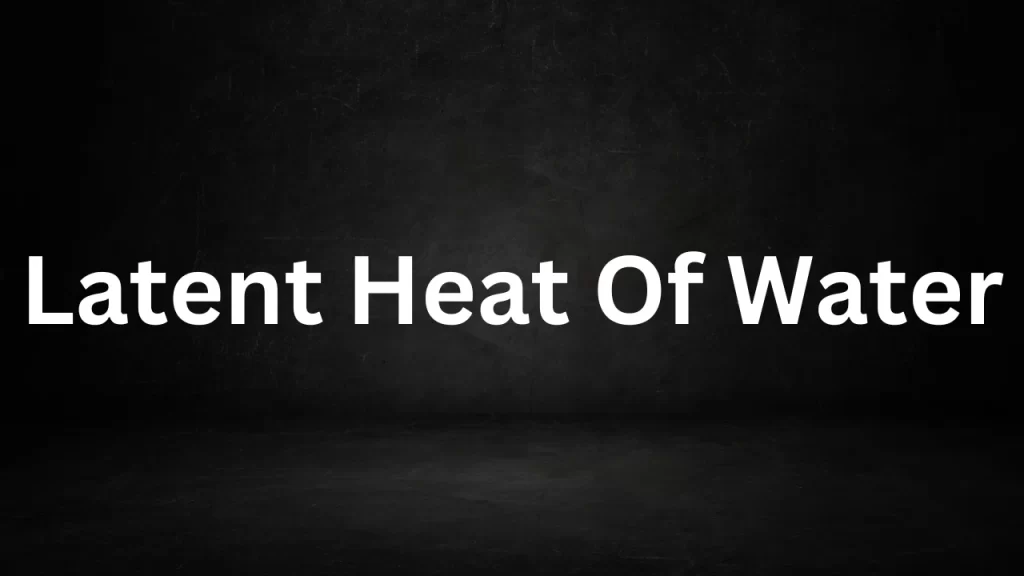Latent Heat Of Water
Latent Heat Of Water: The latent heat of water is a fundamental concept in thermodynamics and describes the amount of heat energy required to change the phase of water from one state to another while keeping the temperature constant.

Latent Heat Of Water
Phases of Water
- Solid (Ice): In the solid phase, water molecules are arranged in a regular, crystalline structure. Heat must be added to convert ice into liquid water.
- Liquid (Water): In the liquid phase, water molecules are loosely arranged, allowing them to flow. Heat is absorbed when ice melts to become liquid water.
- Gas (Water Vapor): In the gas phase, water molecules are highly disordered and move freely. Heat is required to change liquid water into water vapor (evaporation), and heat is released when water vapor condenses back into liquid water.
Latent Heat of Fusion
The latent heat of fusion () is the amount of heat energy required to change one unit mass of a substance from a solid to a liquid phase (or vice versa) at a constant temperature. For water, the latent heat of fusion is approximately 334,000 joules per kilogram (J/kg). This means that to melt 1 kilogram of ice at 0°C into liquid water at 0°C, approximately 334,000 joules of heat energy must be added.
Latent Heat of Vaporization
The latent heat of vaporization () is the amount of heat energy required to change one unit mass of a substance from a liquid to a gas phase (or vice versa) at a constant temperature. For water, the latent heat of vaporization is approximately 2,257,000 joules per kilogram (J/kg). This means that to vaporize 1 kilogram of liquid water at 100°C into water vapor at 100°C, approximately 2,257,000 joules of heat energy must be added.
Significance and Applications
Understanding the latent heat of water is crucial in various natural and practical scenarios:
- Weather and Climate: Latent heat plays a significant role in weather phenomena. The release of latent heat during the condensation of water vapor in the atmosphere is responsible for cloud formation, precipitation, and the release of energy in thunderstorms.
- Cooking: Latent heat is involved in cooking processes, such as boiling and steaming. Heat is continuously supplied to convert liquid water into water vapor, which cooks food.
- Heating and Cooling Systems: In heating and cooling systems, heat pumps utilize the latent heat of vaporization and fusion to transfer heat efficiently.
- Thermal Comfort: Sweating is a cooling mechanism in humans. When sweat evaporates from the skin, it absorbs latent heat from the body, providing a cooling effect.
- Energy Storage: Latent heat storage systems are used in some renewable energy applications to store excess energy for later use. For example, phase-change materials (PCMs) store and release energy during phase transitions.
- Cryogenics: In cryogenic applications, understanding the latent heat of vaporization is crucial for the liquefaction and storage of gases like nitrogen and oxygen.
In summary, the latent heat of water is a fundamental property that governs phase changes in water and plays a pivotal role in various natural phenomena and practical applications, from weather patterns to everyday cooking and energy storage. It is a key concept in thermodynamics and heat transfer.
Read More
- Difference Between Work And Power
- Difference Between Gravitation And Gravity
- Molecular Weight Of H2SO4
- Distance Time Velocity Time Graph
- Difference Between Kinetics And Kinematics
Frequently Asked Questions (FAQs) Latent Heat Of Water
What is latent heat?
Latent heat is the amount of heat energy absorbed or released during a phase change of a substance (solid to liquid, liquid to gas, etc.) at a constant temperature, without a change in temperature.
What is the latent heat of water?
The latent heats of water refers to the amount of heat energy required or released during phase changes involving water. Specifically, it includes the latent heat of fusion (melting or freezing) and the latent heat of vaporization (evaporation or condensation).
What is the latent heat of fusion for water, and why is it important?
The latent heats of fusion for water is approximately 334,000 joules per kilogram (J/kg). It’s the energy required to change 1 kilogram of ice at 0°C into 1 kilogram of liquid water at 0°C. This process is fundamental in weather patterns, ice melting, and heat transfer in cooling systems.
What is the latent heat of vaporization for water, and why is it significant?
The latent heats of vaporization for water is approximately 2,257,000 joules per kilogram (J/kg). It’s the energy required to change 1 kilogram of liquid water at 100°C into 1 kilogram of water vapor at 100°C. This process is crucial in weather phenomena, cooking, and many industrial processes.
How does latent heat affect weather and climate?
Latent heat is involved in the formation of clouds, precipitation (rain, snow, etc.), and the release of energy during thunderstorms. It plays a vital role in Earth’s climate system by redistributing heat in the atmosphere and oceans.